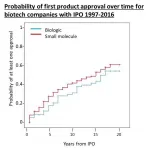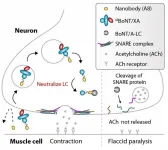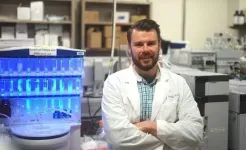Majority of biotech companies completing an IPO from 1997-2016 achieved product approvals
Biotech companies completing IPOs continue to initiate new product development, but 78% were conventional small molecule drugs, not biologicals
2021-01-06
(Press-News.org) A large scale study from Bentley University of the biotechnology companies that completed Initial Public Offerings from 1997-2016 estimates that 78% of these companies are associated with products that reach phase 3 trials and 52% are associated with new product approvals. The article, titled "Late-stage product development and approvals by biotechnology companies after IPO, 1997-2016," shows that these emerging, public biotechnology companies continue to have a role in initiating new product development, but are no longer distinctively focused on novel, biological products.
The new report from the Center for Integration of Science and Industry at Bentley University, published in Clinical Therapeutics, studied the 319 biotechnology companies focused on new drug development that completed Initial Public Offerings (IPOs) from 1997-2016. These companies contributed to development of 367 products that progressed to phase 3 and 144 new drug approvals through 2016, including 78 New Molecular Entities (NMEs). Key point of the study include:
For 70% of the approved products, development was initiated by the biotech company;
77% were developed with corporate partners and 87% were ultimately launched by a pharmaceutical partner or after an acquisition;
Seven products achieved annual sales of more than $1 billion during the study period;
Small molecule drugs, rather than traditional biological products (proteins, cells) comprised 75% of products reaching phase 3 and 78% of approvals.
Reformulations of existing products represented 36% of phase 3 products and 46% of approvals.
These biotech companies contributed to 16% of all New Molecular Entities approved 1997-2016 and 28% of biological approvals.
"We see that over two decades, the majority of newly public biotechnology companies are able to successfully initiate development of products that progress to late stage development or approval, most of which are ultimately brought to market by established pharmaceutical firms." " said Dr. Fred Ledley, Director of the Center for Integration of Science and Industry. "Our study also shows that the product portfolio of biotech companies is no longer distinctively focused on novel biological products or methods, but encompasses a wide range of small molecules and reformulations."
This study is one part of a large survey of the finances and late-stage product portfolios of companies with IPOs from 1997-2016, which show that, by the end of 2016, these companies had both created ~$100 billion in shareholder value and spawned 144 new products. While very few of these companies matured into fully integrated pharmaceutical companies, the long term economic performance of these biotech companies, in terms of market capitalization, shareholder value, fraction of companies acquired, and fraction of companies trading or sold above their IPO value, is similar to that of non-biotech companies with concurrent IPOs. Together these studies suggest that the risk of investing in public biotechnology companies is, in part, mitigated by this diversification into technologies with shorter times from IPO to approval and higher probabilities of success.
INFORMATION:
This study was authored by Dr. Laura M. McNamee, Dr. Ekaterina G. Cleary, Sunyi Zhang, and Usama Salim along with Dr. Ledley. Ms. Zhang was a graduate researcher, and Mr. Salim an undergraduate researcher, at Bentley University. This work was supported by a grant from the National Biomedical Research Foundation.
THE CENTER FOR INTEGRATION OF SCIENCE AND INDUSTRY at Bentley University focuses on understanding and accelerating the translation of scientific discoveries to create public value. The Center is an environment for thought leadership and interdisciplinary scholarship spanning basic science, data analytics, business and public policy. For more information, visit wwwbentley.edu/sciindustry and follow us on Twitter @sciindustry.
Bentley University is more than just one of the nation's top business schools. It is a lifelong-learning community that creates successful leaders who make business a force for positive change. With a combination of business and the arts and sciences and a flexible, personalized approach to education, Bentley provides students with critical thinking and practical skills that prepare them to lead successful, rewarding careers. Founded in 1917, the university enrolls 4,200 undergraduate and 1,000 graduate and PhD students and is set on 163 acres in Waltham, Massachusetts, 10 miles west of Boston. For more information, visit bentley.edu.
Follow us on Twitter @BentleyU #BentleyUResearch.
For news media only:
Corresponding author: Dr. Fred D. Ledley, Director, Center for Integration of Science and Industry, Bentley University, Waltham, MA. Tel: 781.891.2046; email: fledley@bentley.edu
[Attachments] See images for this press release:

ELSE PRESS RELEASES FROM THIS DATE:
2021-01-06
E. coli food poisoning is one of the worst food poisonings, causing bloody diarrhea and kidney damage. But all the carnage might be just an unintended side effect, researchers from UConn Health report in the 27 November issue of Science Immunology. Their findings might lead to more effective treatments for this potentially deadly disease.
Escherichia coli are a diverse group of bacteria that often live in animal guts. Many types of E. coli never make us sick; other varieties can cause traveler's diarrhea. But swallowing even a few cells of the type of E. coli that makes Shiga toxin can make us very, very ill. Shiga toxin damages blood vessels in the intestines, causing bloody diarrhea. If ...
2021-01-06
Taking advantage of the chemical properties of botulism toxins, two teams of researchers have fashioned non-toxic versions of these compounds that can deliver therapeutic antibodies to treat botulism, a potentially fatal disease with few approved treatments. The research, which was conducted in mice, guinea pigs, and nonhuman primates, suggests that the toxin derivatives could one day offer a platform to quickly treat established cases of botulism and target hard-to-reach molecules within neurons. Botulism manifests due to bacterial toxins called botulinum neurotoxins (BoNTs), which are the most potent toxins known ...
2021-01-06
The pandemic has exacerbated isolation and fears for one very vulnerable group of Americans: the 4.3 million older adults with cognitive impairment who live alone.
As the coronavirus continues to claim more lives and upend others, researchers led by UC San Francisco are calling for tailored services and support for older adults living alone with memory issues, who are experiencing extreme isolation, and are exposed to misinformation about the virus and barriers to accessing medical care.
In their qualitative study, researchers interviewed 24 San Francisco Bay Area residents whose average age was 82. Of these, 17 were women, and 13 were either monolingual Spanish-speakers ...
2021-01-06
LA JOLLA--New data suggest that nearly all COVID-19 survivors have the immune cells necessary to fight re-infection.
The findings, based on analyses of blood samples from 188 COVID-19 patients, suggest that responses to the novel coronavirus, SARS-CoV-2, from all major players in the "adaptive" immune system, which learns to fight specific pathogens, can last for at least eight months after the onset of symptoms from the initial infection.
"Our data suggest that the immune response is there--and it stays," LJI Professor Alessandro Sette, Dr. Biol. Sci., who co-led the study with LJI Professor Shane Crotty, ...
2021-01-06
Drug-resistant bacteria could lead to more deaths than cancer by 2050, according to a report commissioned by the United Kingdom in 2014 and jointly supported by the U.K. government and the Wellcome Trust. In an effort to reduce the potential infection-caused 10 million deaths worldwide, Penn State researcher Scott Medina has developed a peptide, or small protein, that can target a specific pathogen without damaging the good bacteria that bolsters the immune system.
Medina, an assistant professor of biomedical engineering, led the team who published its results Jan. 4 in Nature Biomedical Engineering.
"One of the best protective mechanisms we have to prevent infection are beneficial bacteria that inhabit our bodies, known as commensals," ...
2021-01-06
Ikoma, Japan - Ultrasmall integrated circuits have revolutionized mobile phones, home appliances, cars, and other everyday technologies. To further miniaturize electronics and enable advanced functions, circuits must be reliably fabricated in three dimensions. Achieving ultrafine 3D shape control by etching into silicon is difficult because even atomic-scale damage reduces device performance. Researchers at Nara Institute of Science and Technology (NAIST) report, in a new study seen in Crystal Growth and Design, silicon etched to adopt the shape of atomically smooth pyramids. Coating these silicon pyramids with a thin layer of iron imparts ...
2021-01-06
ITHACA, N.Y. - For more than seven years, a mysterious wasting disease has nearly killed off sea star populations around the world. Some of these species stand at the brink of extinction.
New Cornell University-led research suggests that starfish, victims of sea star wasting disease (SSWD), may actually be in respiratory distress - literally "drowning" in their own environment - as elevated microbial activity derived from nearby organic matter and warm ocean temperatures rob the creatures of their ability to breathe.
"As humans, we breathe, we ventilate, we bring air into our lungs ...
2021-01-06
In the digital age, data traffic is growing at an exponential rate. The demands on computing power for applications in artificial intelligence such as pattern and speech recognition in particular, or for self-driving vehicles, often exceeds the capacities of conventional computer processors. Working together with an international team, researchers at the University of Münster are developing new approaches and process architectures which can cope with these tasks extremely efficient. They have now shown that so-called photonic processors, with which data is processed by means of light, can process information much more rapidly and in parallel - something ...
2021-01-06
Young adults ages 18-24 years old in the U.S. say that porn is their most helpful source of information about how to have sex, according to a new study led by a Boston University School of Public Health (BUSPH) researcher published in the journal Archives of Sexual Behavior.
In the nationally representative survey, a quarter of young adults said porn was their most helpful source of information about how to have sex. Slightly less than a quarter said sexual partners were the most helpful source, and fewer pointed to friends, parents, media, or healthcare professionals. However, female respondents were much more likely than male respondents to report that their partners ...
2021-01-06
2020 was an eventful year, with science at the front and center of most news cycles. As this seemingly long year wraps up, Chemical & Engineering News (C&EN), the weekly newsmagazine of the American Chemical Society, is highlighting the biggest chemistry stories, top research trends and predictions for the coming year.
Predictably, research on the novel coronavirus was the biggest chemistry story of the year, beginning in January when the genetic code for SARS-CoV-2 was published. Since then, thousands of papers have been published on the subject, with topics like mask efficacy, disinfectants and virus transmission getting the most attention. Other popular chemistry subjects included new insights about the atmospheres of other planets and how climate change fueled ...
LAST 30 PRESS RELEASES:
[Press-News.org] Majority of biotech companies completing an IPO from 1997-2016 achieved product approvals
Biotech companies completing IPOs continue to initiate new product development, but 78% were conventional small molecule drugs, not biologicals



